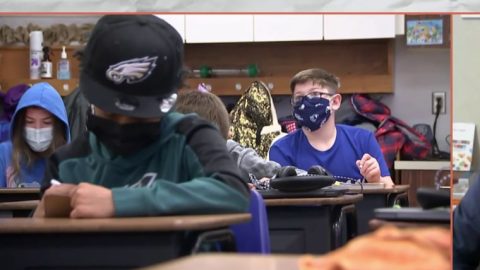
Typing may be faster than writing by hand, but it’s less stimulating for the brain, according to research published Friday in the journal Frontiers in Psychology.
After recording the brain activity of 36 university students, researchers at the Norwegian University of Science and Technology determined that handwriting might improve learning and memory.
At the start of the experiment, the students were told to either write words in cursive using a digital pen on a touchscreen, or to type the same words using a keyboard. When a word such as “forest” or “hedgehog” appeared on a screen in front of them, they had 25 seconds to write or type it over and over.
Meanwhile, a cap of sensors on their head measured their brain waves. The cap’s 256 electrodes attached to the scalp and recorded the electrical signals of the students’ brains, including where brain cells were active and how parts of the brain communicated with each other.
“Our main finding was that handwriting activates almost the whole brain as compared to typewriting, which hardly activates the brain as such. The brain is not challenged very much when it’s pressing keys on a keyboard as opposed to when it’s forming those letters by hand,” said Audrey van der Meer, the study’s co-author and a neuropsychology professor at NTNU.
In particular, the study found that writing by hand required communication between the brain’s visual, sensory and motor cortices. People who wrote with the digital pen had to visualize letters, then use their fine motor skills to control their movement when writing.
“When you have to form letters by hand, an ‘A’ will look completely different than a ‘B’ and requires a completely different movement pattern,” van der Meer said.
By contrast, when typing, the keys look mostly the same, regardless of the letter. As a result, the study found, typing required less brain activity in the visual and motor cortices.
“Because only small parts of the brain are active during typewriting, there is no need for the brain to communicate between different areas,” van der Meer said.
Van der Meer’s previous research in children and young adults similarly found that people’s brains are more active while writing by hand than while typing. A 2017 study from Indiana University also indicated that writing by hand could link visual and motor skills, which might help kids better recognize letters.
But so far, there’s mixed evidence as to whether taking notes on paper versus a laptop can help people remember and understand information better in the classroom or raise their performance on tests.
It’s also hard to know whether or how the brain activity in the new study might translate into real-life improvements in learning or memory, said Ramesh Balasubramaniam, a neuroscientist at the University of California, Merced, who wasn’t involved in the research.
The study showed that when students write by hand, “a lot of the connections are happening from the frontal and temporal regions of the brain, which are more memory-related,” he said. But a future study could actually “test the participants for what they remember from things that they hand-wrote and what they typed.”
Balasubramaniam said older adults might also see cognitive benefits from handwriting, “but I think the largest benefits are when the brain is still developing, because it kind of coincides with other major learning processes that are happening.”
In the United States, the Common Core set of academic standards, adopted by most states, calls for kids to learn handwriting in kindergarten and first grade. It also sets typing milestones for fourth, fifth and sixth graders.
“Kids are currently being taught handwriting. They will always be taught handwriting. How much they actually use handwriting is going to be a mixture of their own personal preferences and then the expectations of the classrooms that they’re in,” said Morgan Polikoff, an associate professor of education at USC Rossier School of Education.
Writing by hand can be more beneficial for some children than others, he added.
“Some kids maybe have fine motor issues, so handwriting will be a challenge for them,” Polikoff said. On the other hand, “there’s some evidence that handwriting, especially cursive handwriting, works especially well for students with dyslexia.”
The U.S. has seen some political pressure to require cursive in schools. California, for example, passed a law last year mandating that public school teachers give some cursive instruction from first through sixth grade. Polikoff estimated that roughly 20 states have some sort of cursive requirement.
But scientists don’t know if cursive offers any additional cognitive benefits over writing in print.
Polikoff said some people support teaching cursive simply because historical documents were written that way, people traditionally sign their names in cursive or just that “it’s a lovely dying art.”
On the other hand, van der Meer said she’s often “accused of wanting to go back to the Stone Age” by advocating for students to write by hand in schools. Both handwriting and typing should have a place in the classroom, she said.
“We live in a digital world and the digital world is here to stay,” van der Meer said. “If you have to write a long essay or a long text, then obviously it’s much better to use a computer.”










Recent Comments